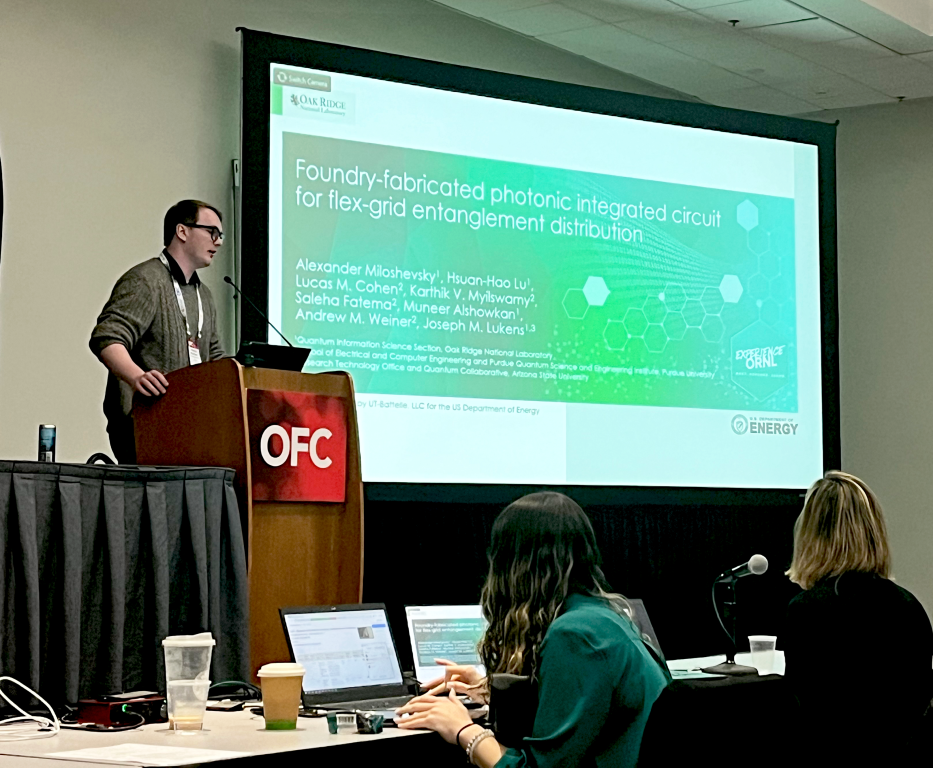
The Department of Energy's Oak Ridge National Laboratory was front and center recently at one of the world's largest optical networking conferences, the 2024 Optic Fiber Communication Conference and Exhibition, or OFC. ORNL researchers had major roles at the OFC 2024, a three-day event held in San Diego, California from March 26-28 which featured thousands of the world's leading optical communications and networking professionals.
"OFC is one of the premium optical fiber conferences and it's very well known for developments in optics in industry and demonstrations," said Mariam Kiran, group leader for the Quantum Communications and Networking group at ORNL.
Kiran was part of the OFCnet organizers, the group responsible for bringing a high-speed optical network on the OFC showfloor that links all booths and showcases the networking capabilities of the networking products on display. Kiran was one of over 60 people, coming from industries, universities and labs, who volunteered their time to understand and deliver the next generation of networking research.
"As part of the OFCnet Measurement and Security team, we developed a monitoring backend that uses statistics and machine learning to show the network advances being showcased at OFC. In particular we had more than 15 demonstrations showcasing novel innovations for quantum networks, from real-world deployments, quantum routers, memories and more," said Kiran. "We are working with the companies and their demonstrations to develop another layer of intelligent data capture to understand how researchers can benefit from their experience and, also together, how can we push the current state of the art for a quantum internet."
In addition, ORNL postdoctoral research associate Alex Miloshevsky presented his novel research in quantum networks, detailing ORNL's progress with quantum technology. Miloshevsky works to enable commercialized quantum networks via photon-entangled sources, which are the building blocks to create entanglement that will fuel quantum networks. He showed how photon tangled sources can be miniaturized to fit on a single chip, an important development for future commercialization of this technology.
"The idea would be that in the future, people will use photonic integrated circuits as a platform, take all the parts of the quantum process like generation and processing and put it all in one chip," Miloshevsky said. "Instead of being all over the big table, it would be on one tiny chip and be a lot more efficient."
Miloshevsky added, "This conference promotes the work that we're doing. That increases collaborators, sponsors and the people coming to us seeking expertise."
Quantum networking is gaining attention around the world for its potential to accelerate quantum computers and enhance the security of critical infrastructure, such as banking systems and the electric grid.
ORNL has made a significant investment in advancing quantum technologies, including establishing the Quantum Science Center in 2020.
"Quantum networking is a field that is still developing," Kiran said. "We're seeing a plethora of different tools coming to light. Some people are developing the quantum router, some the quantum memory and some the quantum switches. Everyone's doing their own bit to contribute to this big research field, and OFC is very interesting because it's a place where all these industries come together."
"It (OFC) allows people to provide us with feedback during the conference," Miloshevsky added. "They can raise important questions that tell us or lead us to what to do in the future or things that we might have overlooked that we need to go back and look at a little deeper."
The 2024 OFC Conference and Exhibition welcomed more than 13,000 participants from 74 countries, 87 media outlets, with more than 603 exhibiting companies.
UT-Battelle manages ORNL for DOE's Office of Science, the single largest supporter of basic research in the physical sciences in the United States. DOE's Office of Science is working to address some of the most pressing challenges of our time. For more information, visit https://energy.gov/science.






